If there’s one thing the Napoleonic period has going for it for the historical wargamer, it’s the fanciest uniforms ever put to battle. The French were resplendent in blue, the British in incredibly fiddly red with padded shoulders and the Austrians in blinding white set off with fetching red accents. When looking for something new to add to my French Guard that would add a little colour and unusual character, I came across what must be the greatest, flashiest uniform of all time: The Berg Lancers. In this article we’ll have a deep dive into who they were and how you can represent them on the battlefield.
Neither Holy, nor Roman, nor you get the idea….
Understanding who the Berg Lancers were depends on understanding at least a little of the insanely complicated history of the Holy Roman Empire. The Great Duchy of Berg was one of Napoleon’s little vassal/ally states formed along the Rhine river in his grand shakeup of the European political and diplomatic scene after the crushing victory of Austerlitz and the defeat of the Third Coalition.
when the French Revolution began, the Holy Roman Empire was possibly at the peak of its complexity, a patchwork of small states, Austrian and Prussian competing territorial interests and large Duchies and Electorates. Between the Peace of Westphalia in 1648 and the French Revolution, these had been consolidated and coalesced into power blocs of varying size. For the Austrians – the Holy Roman Emperors – it was a complicated but incredibly wealthy and powerful part of their attempts to project hegemonic power over all of Europe. For the French, it was a source of allies and enemies by turn – but always a threat. Caught between Prussia, Austria and Russia in the East and the French in the West, with the rise of Napoleon’s empire, the situation was unsustainable.
With the Austrians and Russians not just defeated at Austerlitz but effectively humiliated in the Peace Of Pressburg, Napoleon consolidated HRE territory to his key German Allies Wurttemberg, Baden and Bavaria. Rising from this was the Confederation of the Rhine, a collection of 9 major states and 27 duchies ranging from fairly large to comedically small. The Confederation was both a buffer against the major powers to the east, a direct insult to the Holy Roman Emperor (the HRE itself was formally dissolved soon after) and a powerful military and economic force in Napoleon’s wars.
The Grand Duchy of Berg
The Grand Duchy of Berg was one of the initial states of the Confederation, formed from welding together the Duchy of Berg and the Duchy of Cleves. Berg was effectively traded from the King of Bavaria (also a Confederation member) in exchange for Ansbach, one of those horse-trading deals that happened a lot in the HRE that seem pretty baffling in a post-nationalism world. Napoleon, looking for reliable, sensible politician-generals he could implicitly trust to follow his orders on the battlefield and European political stage clearly couldn’t find any, because the new Grand Duchy went to noted absolute hound Marshal Joachim Murat, a point that will become very important later.
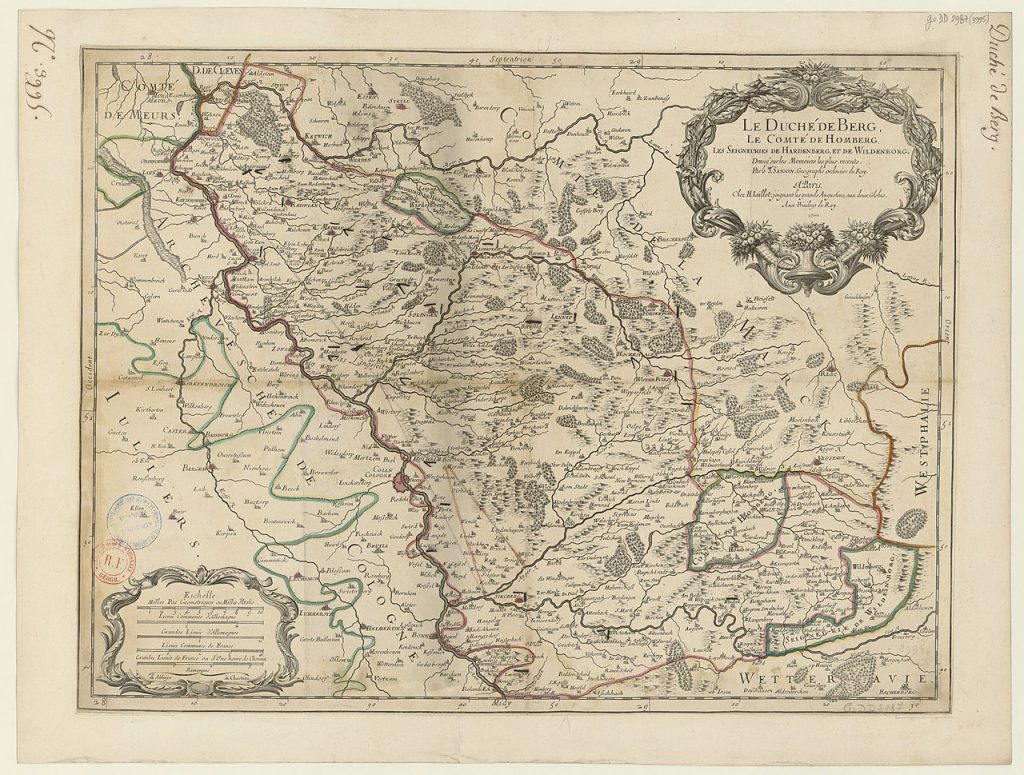
Berg never had much of a chance as either an independent state or as a solid buffer. Its proximity to France (right on the border), initial rulership by Napoleon’s brother in law, adherence to the economic warfare of the Continental System and finally having the leadership shuffled through Napoleon’s nephew in a variety of complicated personal unions led eventually to it being formally absorbed into France – but not for very long. Berg contributed around 5,000 men to the invasion of Russia, when Napoleon at the height of his power led Europe’s largest army to date. It was a truly multinational invasion force, but few would return – nearly all would find their death in the snow. The end of the Duchy of Berg is tied up into the Russian Debacle. From a powerful Confederation chafing under French rule but with few meaningful options, Russia transformed Germany into a hotbed of states angling towards independence, or even German unification. Berg was little different and after Napoleon’s defeat at the Battle of Leipzig in 1813 when the French began their long, terminal defensive campaign towards Paris, the confederation and eventually the Duchy itself came under Prussian hegemonic power. It became part of the Prussian buffer state against France, eventually to be part of Westphalia.
The Berg Lancers
Berg would be one of many fairly unremarkable French satellite states, were it not for the Lancers. The Berg Lancers – more properly the Berg Chevau-Leger were to some extent the brainchild of Joachim Murat, a man who loved three things more than anything else in the world: Women, Cavalry and Uniforms. I am sure in his short, swashbuckling himbo life, he combined all three on a regular basis. Murat, wanting a personal guard to not only project gravitas but also to allow him free reign with uniform design, requested (and was granted) permission to skim off chosen men from the Hussar and Chasseur regiments of the French army, as well as recruit from Berg and other German states. It took him several years to do so, eventually arriving at a French-style Chasseur/Light Horse unit with a ridiculously expensive uniform that proved fairly ruinous for the terrible finances of the Duchy.

Murat never really bothered with actually going to Berg, so his commands are infrequent, contradictory and overlapping, upping the pay to Guard levels, commissioning an even nicer uniform, paying tailors and artists to start working on a third uniform design and doing all this from a lounge in France. At some point, they transitioned from Light Horse to Polish-Style Lancers, picking up the Polish Czapka along the way. By 1808, two years after the idea popped into his curly haired, almost completely smooth, brain the Berg Light-or-Lancers were on their way to Spain. 200 men sharing 50 horses.
When Napoleon shuffled his Kings around in 1808, Murat got Naples, kicking off an exciting 7 years of treachery, bravery and magnificent curly hair, and the Lancers lost their patron. They ended up fighting in Spain, given a significantly cheaper uniform, receiving irregular reinforcements and often adjacent to or counted alongside Young Guard regiments. There’s the usual incredibly confusing and poorly researched period of “fucking about with regimental designations” in the period between 1809 and 1812, where the regiment was split up, amalgamated, shuffled about and various administrative annoyances. What we can conclusively say is that three new squadrons were formed in Germany in 1812, forming the 2nd Regiment of Berg Lancers. These poor bastards would be sent to Russia – very few survived. In the meantime, the 1st Regiment, Murat’s original Guard, were being decimated by hard service in Spain where they won significant renown. When Napoleon desperately began to raise a new army in 1813, the units were merged into one unit, which fought for the French throughout the German Campaign.
The Berg Lancers were part of the famed “Brigade Colbert” under General Pierre-David Colbert, alongside the more famous Dutch “Red” Lancers. The apex of their military career – in terms of la gloire if nothing else – was probably the Guard Cavalry charge at Bautzen in 1813, crashing through the Allied line and forcing Blucher and the Tsar back. They fought in the long retreat to France, but once past the Western border with Berg, they became increasingly unreliable (wouldn’t you be?) and the regiment was dissolved.
Uniforms
There are three key phases of Uniform worn by the Lancers at varying times, and there’s a clear change in the level of fanciness associated with them once Murat is too busy in Naples to get personally involved in designing exactly what his horse would wear.
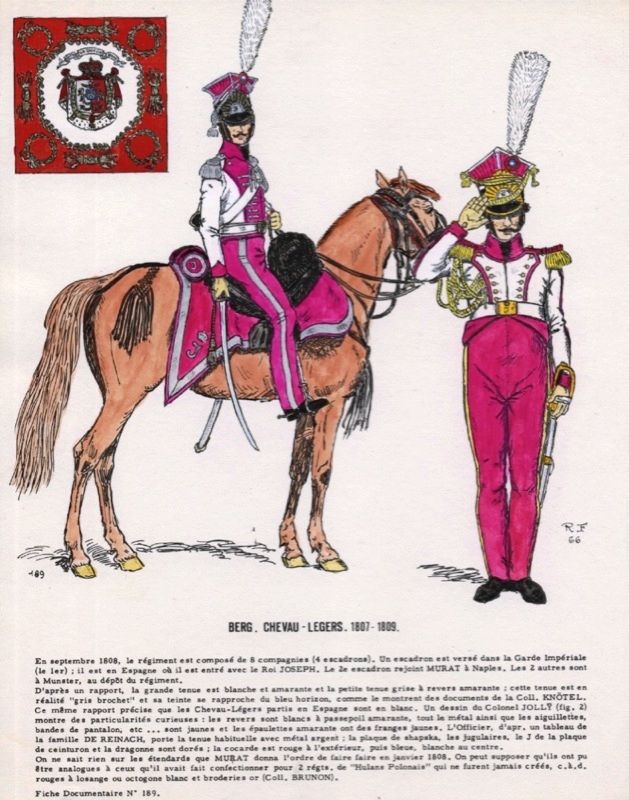
The most famous uniform is the earliest, a classic Murat-designed over-fancy farce. Initially he’d wanted the full Hussar uniform with pelisse (the cute little jackets the Hussars wore), but settled for a light buff (later moving to White) and pink Polish Lancer-style uniform with broad lapels, epaulettes and striking crimson trousers. This seems to have been the uniform up until 1808. Napoleonic uniforms, for all that they’re extensively and groggily documented, were in fact a real shitshow, so it’s unknown if this was the full Polish cut of jacket (the Kurtka) or the French habite-veste, and the colour of the trousers could have been fully pink or buff/cream/white with pink stripes.
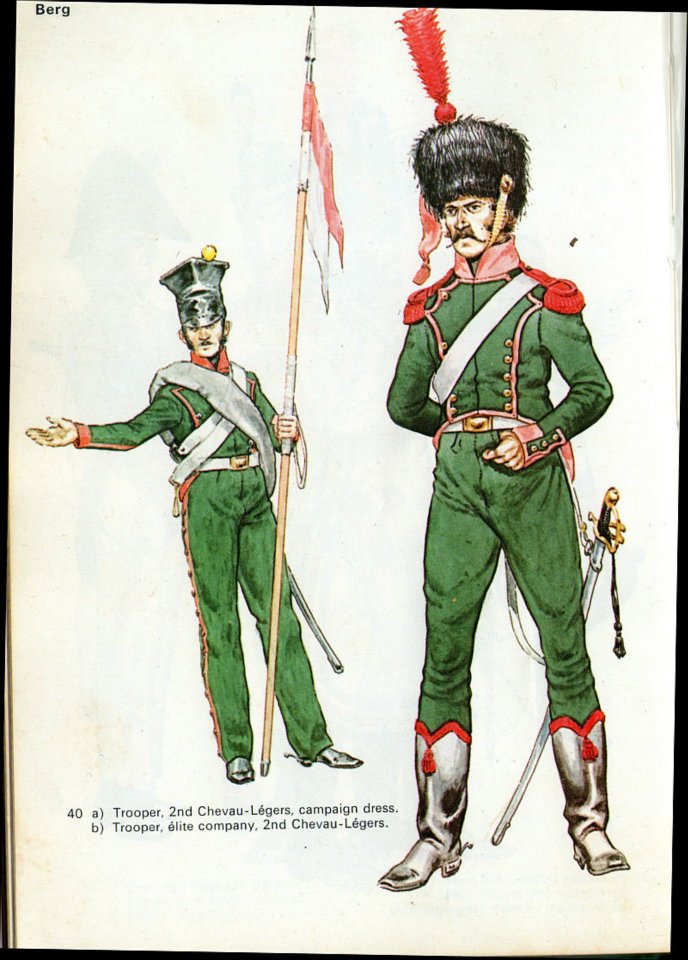
It was replaced with a much more utilitarian – and cheaper – Chasseur style uniform, with the single breasted jacket, this time in the fairly standard French green, though pink crept in with the trim on the habite-veste and the collar. It’s difficult to find out how long the Lancers had this uniform for – in fact it’s likely that this was their uniform for a brief period and only for those squadrons reinforcing their regiment in Spain. It seems like quite a fleeting thing, or possibly even an invention of uniform-obsessed historians trying to rationalise the very confused uniform logistics situation between the various fronts, wars and phases of the period.
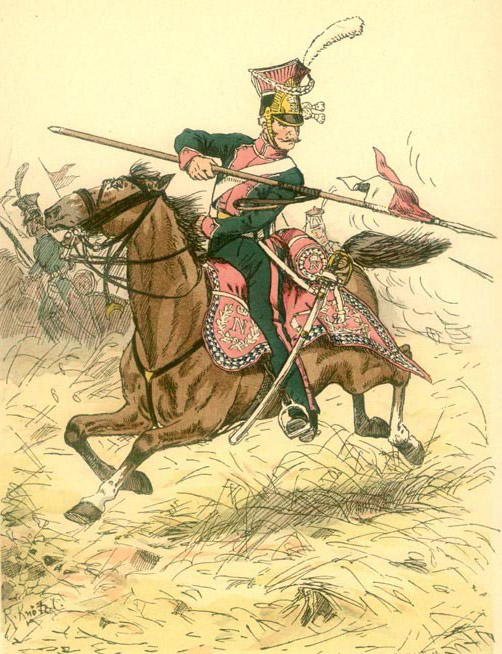
The uniform most relevant to my army with it’s 1813 theming is the final, potentially more standardised, uniform that the Lancers fought in in the final year of their history. Here, it appears as a standard Lancer uniform, with pink and green predominantly featured, with little half-epaulettes which no doubt have a specific name I’m not aware of. There are many interpretations of what this uniform actually looked like, whether in dress, parade or field – so we don’t have a solid, incontrovertible way of depicting the Berg Lancers. Instead, I’ll be doing something based on the below image with a bit of Knotel thrown in.
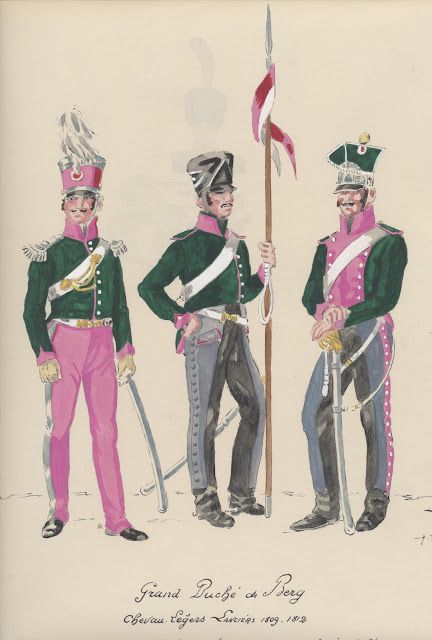
Making Berg Lancers
With the uniform fairly well established, I started thinking about how I could reasonably put this unit together. My usual first port of call – “do the Perry Brothers make this?” didn’t work, unfortunately. You can buy many different versions of metal lancers – but since I’m going to put eight of them onto one big base, it really has to be plastic (otherwise I’d barely be able to lift the bloody thing). There are a number of lancer kits out there in plastic and for any project likely to involve lots of sanding, chopping or bits swapping I always start from a plastic base. The three contenders were the Victrix Guard Lancer kit, the Warlord Line Lancer kit and the Perry Chasseurs a Cheval.
Right off the bat I ruled out the Perry Chasseurs – there are depictions of the Berg Lancers in Chasseur style uniform, but that’s not the uniform, or the period I’ve settled on for my unit. The Chasseur uniform is single-breasted, lacking the fabulous lapels that will give the Lancers much of their colour. I’d also have to make lances – not too difficult given some straight wire, but a lot of work with file and knife to turn sabre-clutching hands into lance holding ones.
The Victrix Guard Lancers are one of the nicest kits out there, and have the right basic uniform, but they’re very much – and very clearly – Guard Lancers, with prominent braiding, fancy shabraques (the pointed saddlecloth) and epaulettes, all elements I would have to remove to pull off the Berg Lancers in their battered post-Russia 1813 form. The Guard Lancers will have to wait for another project, and I’m looking forward to that one too!
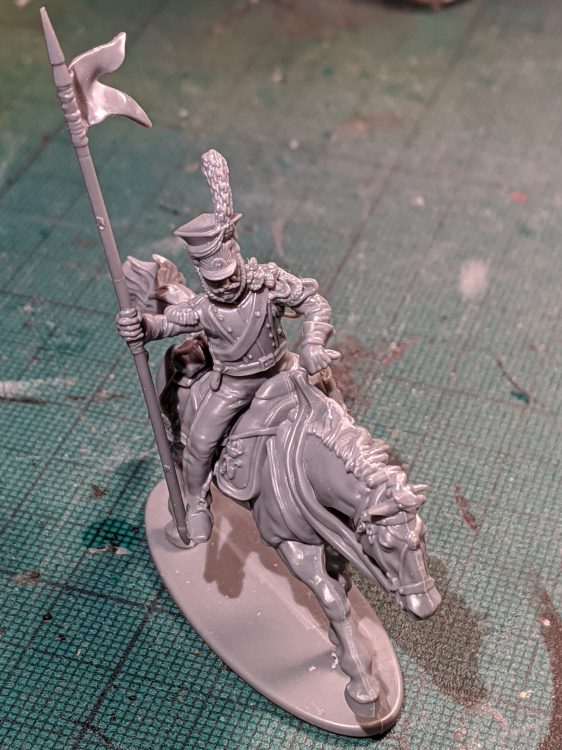
The Warlord Line Lancers it was. They’re in the right uniform on top – double lapels and high collar – and conveniently already come with lances and their horse accoutrements are right for the Berg Lancers. The heads were the only immediately obvious issue, but the Warlord Vistula Legion Greandiers in Czapkas provided an acceptable alternative.
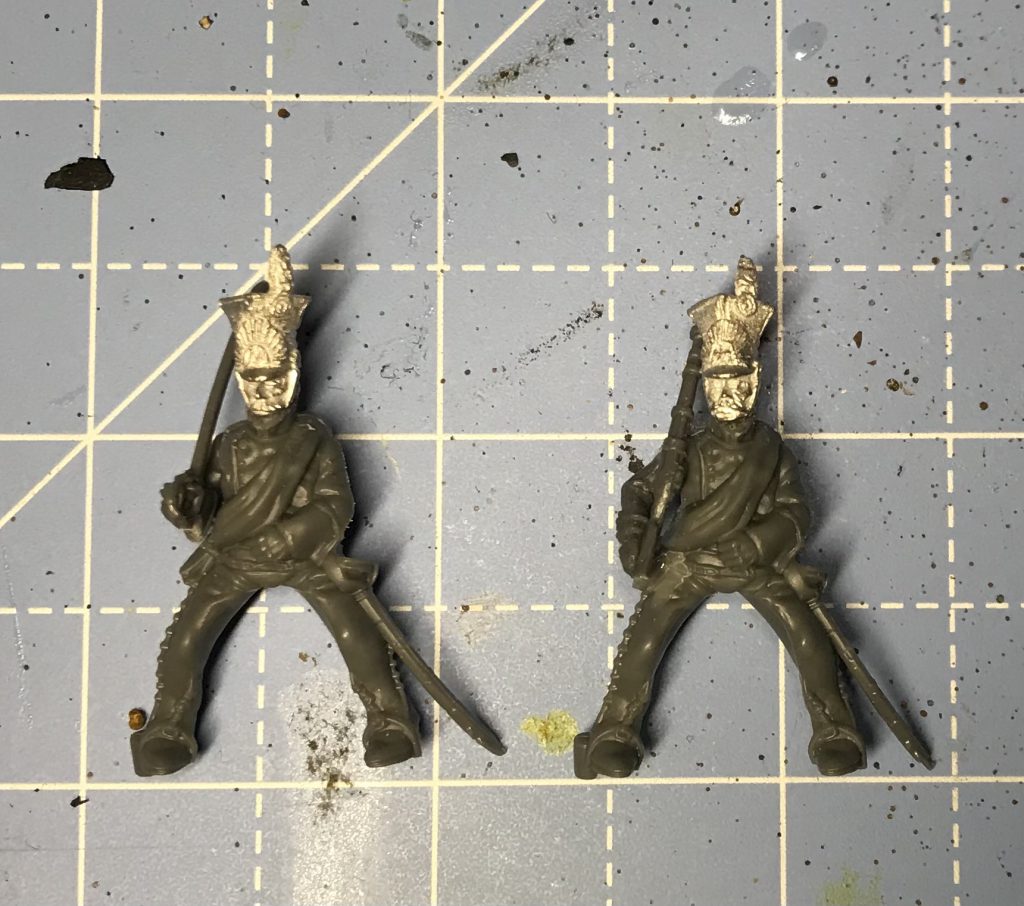
On opening the box to get started, I remembered why I’m usually just on Victrix and Perry for my Napoleonic plastics. The Line Lancer kit is fine. It’s a simple to build, three-piece soldier on a horse model derived, I’m sure, from the extremely old Marauder Miniatures plastic horse. The detail is good where you need it to be, and the plastic is of good quality. It’s not a bad kit by any means, just an old fashioned kit, not up to the standard the Perrys and Victrix have established with modern Napoleonic plastics. The models go together well, and only a little conversion was needed on some of the trousers (to remove the buttons and smooth over the legs into a proper two-stripe Napoleonic cavalry trouser) and a little trimming around the heads. Changing only some trousers into coveralls adds more variety to a fairly same-y kit. The models are made with lancer gloves, which the lancers probably had, but I’ll paint the sleeves of the gloves as the cuffs of the jacket – might not be right, but hell, you make do with what you have.
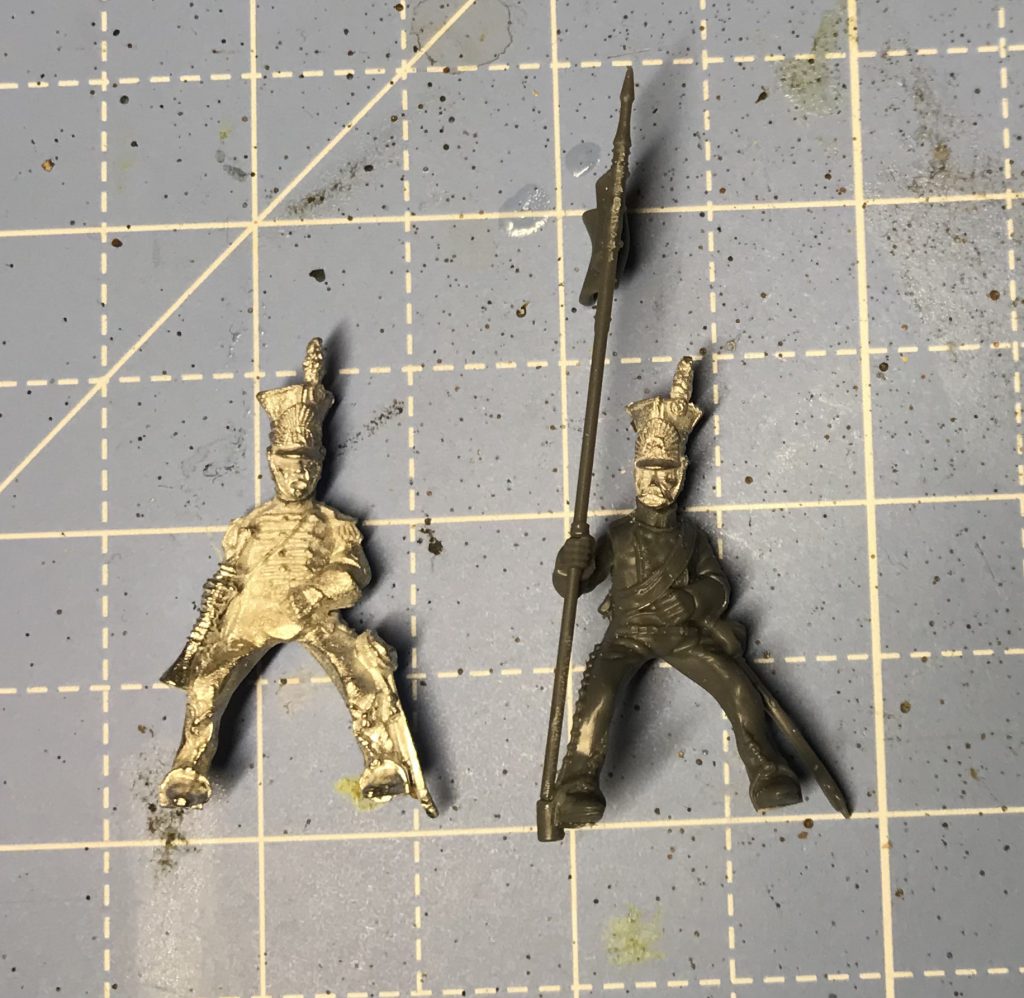
Since the Berg lancers are at the very end of their tether when fighting for my 1813 army, I decided to mix Lances, Sabres and even one or two carbines, representing a unit that no one is that interested in supporting anymore, and is fighting alongside the Guard with one eye on home. They’re at the tail end of a long, hard campaign, so a scattering of different weapons and heavy weathering lets me build that narrative visually. Adding a little visual difference through weapons choices also let me disguise the fact there are only six different heads for the eight man unit! As always for my cavalry, I based eight to a big square, largely because this is huge fun to guide around the battlefield making horsey noises.
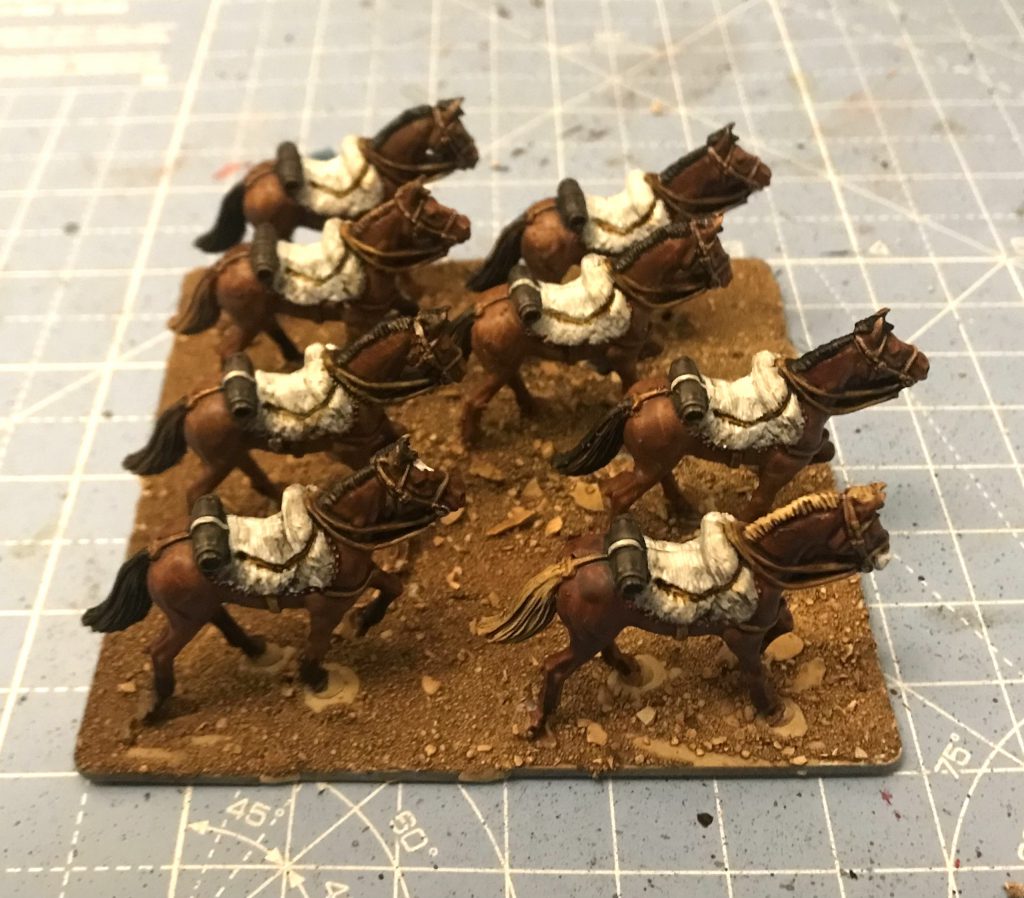
Painting
If there’s a knack to painting horses well, I don’t have it. Luckily, a simple base colour followed by a suitable contrast wash gives me enough detail on the horse itself that I’m happy with it. The green uniform is a combination of Army Painter Witch Brew and Astra Militarum Green Contrast paint to knock it a little darker and thin it out at the same time, then highlighted up with the Witch Brew. I went a little brighter than the dark green I’ve used on my Flanquer-Chasseurs and in the images above to represent those uniforms being at the very end of their usable lives, faded from the sun and with heavy staining.
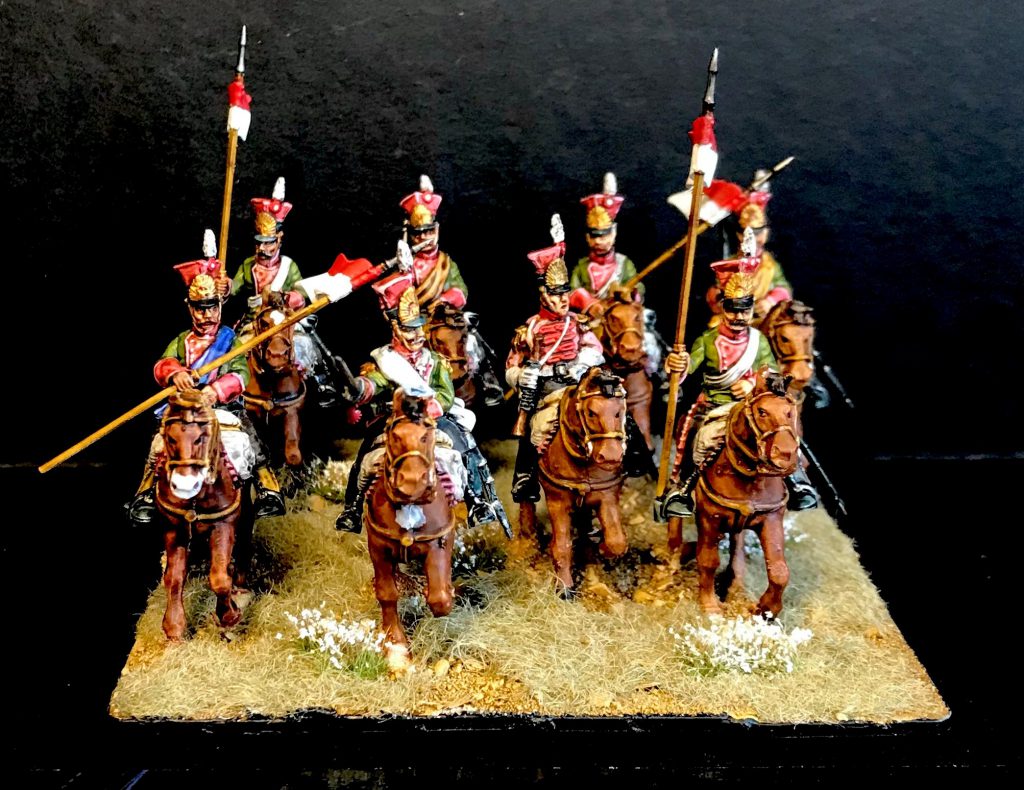
The pink was a very simple white base with a base layer of pink mixed from GW Evil Sunz Scarlet and white, highlighted with a 75:25 mix of the same and then knocked back with the ubiquitous flesh wash! I like how it’s come out, bright enough to be the famous pink lancers but dirty and shaded enough to make them look a bit lived in. The images are a little more vivid than in real life – a new painting/photographing lamp is doing some strange work to a much more muted colour scheme!
Playing the Lancers
Lancers make pretty excellent anti-infantry cavalry in many games, and ideally I’ll be using them to crack otherwise tough infantry that I’ve been attempting to clear out with bayonet and musket butt.
In Black Powder, Lancers impose a solid -2 to morale saves of infantry and cavalry, almost assuring they’ll hit very hard on the charge and break anyone they come into contact with – sweeping advances count as well, so with proper manoeuvring, you can expect a lancer charge to smash through two line units. I’ll use the Berg Lancers as Guard Lancers, giving them Marauders and Reliable – they’ll be near guaranteed to get activations off regardless of where they are on the battlefield. Hopefully, after smashing through an exposed line unit, they can roam around the backfield – a potent (and highly manoeuvrable) threat where my heavy cavalry – the Dragoons and Cuirassiers – struggle to rein themselves in, rally shock and get back into the fight.
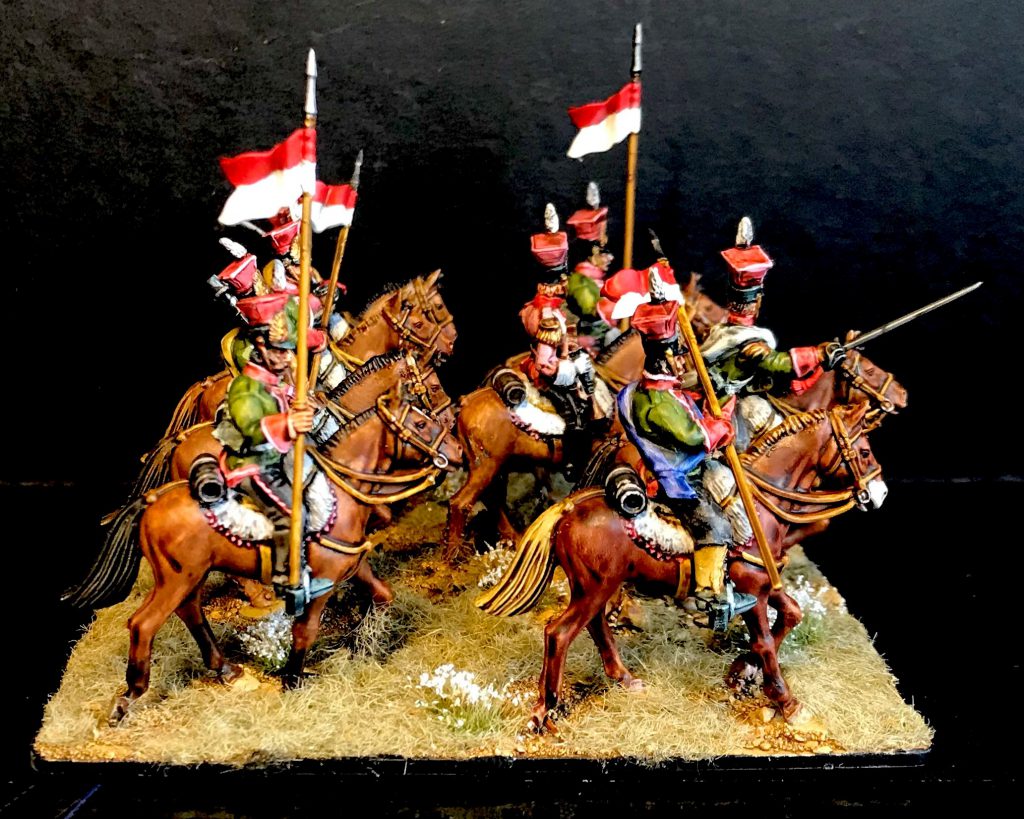
In Sharp Practice, these guys won’t be the heavy line breakers of my Cuirassier cavalry. Instead, they’ll be used to chase off those Bloody British Rifles that are the bane of my existence. These are Lancers in the French Peninsular list (though then they’d be in their cream and amaranth uniform!) which gives them a solid ability in the form of Tally Ho! where using two additional command cards adds an extra d6 of movement to their already incredibly zippy speed, and with an added 2d6 to any melee combat arising from the charge. Unfortunately though they’ll mostly lose that against any regular infantry as they’re rated quite low in the troop quality table – on par with Skirmishers. As a result, I’ll be using them as a lurking threat to chase down any enemy units with heavy shock, skirmishers or cannon – they’re pretty bloody quick and hopefully they can catch Sharpe and company before they take out any more of my officers.
Forward Lancers!
I’m really pleased with how they’ve come out in the finished unit. A very simple headswap, a bit of converting and kitbashing and a little research and we have a unique unit to follow my Imperial Guard around! A unit of light cavalry gives me a fleet-of-hoof unit accompanying my much heavier cuirassiers and dragoons. Converting up historicals kits isn’t something that everyone does, but hopefully this article shows it’s easily doable and can add some real additional character – and colours – to your army. Let us know in the comments if you’ve done anything similar!
Have any questions or feedback? Drop us a note in the comments below or email us at contact@goonhammer.com.


